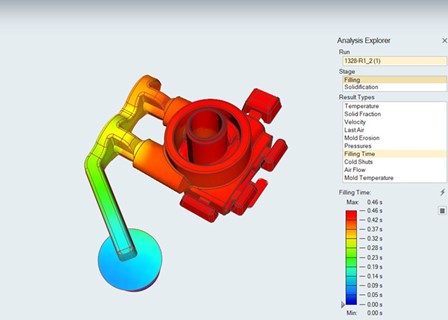
High Pressure Die Casting (HPDC) comes ahead as one of the most dependable and fast production
processes for manufacturing high-volume metal components that are net-shaped and maintain tight tolerances at an
affordable cost. The process involves injecting molten metal alloy under high pressure into a precision die to
achieve accurate and repeatable results.
At Bombay Metrics, we have built our reputation on mastering both Hot and Cold Chamber Die
Casting. This dual expertise allows us to offer an unparalleled range of solutions—whether for small
intricate parts or large structural components—ensuring each client receives the ideal process for their specific
needs.
6 Pillars That Drive Precision in HPDC
- Wall Thickness: Refers to the thickness of the metal walls that form the part. It is a key
design factor that directly impacts metal flow and solidification. - Parting Line: The line or surface where the two halves of the die (cover die half and
ejector die half) meet. It defines the separation point of the mold cavity. - Draft Analysis: Ensures smooth part ejection without sticking, tearing, or damaging the
surface. At Bombay Metrics, draft angles are systematically analyzed for optimal results. - Holes and Windows: Properly designed holes and windows serve as ventilation, drainage, or
integration points. We ensure accurate diameter, depth, and location to prevent defects or functional
issues. - Ribs: Designed carefully to provide rigidity and strength without adding excess weight or
cost. Ribs enhance structural performance and reduce distortion. - Fillet Radii: The rounded curve at the intersection of two walls helps avoid sharp corners,
improving both performance and flow characteristics.
The Essential External Processes That Make HPDC Successful
At Bombay Metrics, tonnage calculation is carefully applied to:
- Select the right HPDC machine (e.g., 250T, 400T, 800T, 1200T) based on part size.
- Formula: Clamping Force = (Overall Projected Area × Specific Injection Pressure × Factor of
Safety) / 1000 - Prevent defects such as flashing, short filling, or dimensional inaccuracy.
- Optimize machine utilization by avoiding under-tonnage (leakage risk) or over-tonnage (higher energy cost).
- Ensure consistent quality for automotive, aerospace, and industrial aluminum components.
Bombay Metrics uses simulation tools and DFM analysis to calculate accurate tonnage requirements
before production begins—ensuring efficiency, precision, and consistent quality.
Flow Simulation
At Bombay Metrics, the flow simulation tool is an integral part of the Design for Manufacturability
(DFM) stage. It is used to:
- Validate die design before tool manufacturing.
- Optimize injection parameters such as temperature, velocity, and pressure.
- Reduce rejections by predicting potential issues early in the design phase.
- Ensure cost-effectiveness by minimizing material waste and tool rework.
- Collaborate transparently with clients by sharing simulation reports to build confidence in product quality.
By combining simulation technology with real-world expertise, Bombay Metrics
ensures that every aluminum die-cast component meets global standards of quality, reliability, and performance.

Die Design Process to Meet Market Trends
- Optimized Design: Collaboration with clients ensures that each design is compact, sturdy,
and cost-effective, fulfilling functional requirements within target timelines. - Enhanced Manufacturability (DFM Integration): Potential risks in tool and product
manufacturing are identified and mitigated before launch. - Optimized Flow and Thermal Management: Advanced simulations help achieve the best gating,
runner, and cooling system for consistent quality. - Advanced Engineering Tools: Use of CAD/CAM and simulation software enables highly precise
die modeling and performance prediction. - Flexible Volume Production Readiness: Dies are designed for durability and repeatability,
supporting scalable manufacturing with minimal downtime. - Precision and Global Quality Compliance: Our products meet stringent global standards
across sectors like automotive, aerospace, lighting, e-mobility, and energy.

Comprehensive Solutions and Technical Support by Bombay Metrics
At Bombay Metrics, we go beyond manufacturing by providing value-added support in tool
development and tool life management. To meet diverse client needs, we offer flexible options balancing
cost, durability, and production requirements:
- 25K Shots: Economical option ideal for low-to-medium production volumes.
- 50K Shots: Balanced solution offering extended tool life for consistent, medium-scale
production. - 100K Shots: Premium solution designed for long-term, high-volume production with maximum
durability and efficiency.
By offering these tailored options, we help customers choose the most cost-effective tooling
solution aligned with their production goals — ensuring optimized investment, longer tool performance,
and improved profitability.
“Bombay Metrics provides end-to-end flexibility, ensuring clients get the most suitable
manufacturing solution for their material, design, and performance requirements. With our commitment to
global quality standards, sustainable manufacturing, and customer-focused innovation, we deliver parts that
combine strength, precision, and efficiency — meeting business needs for Pressure Die Casting Dies on time,
every time.”



